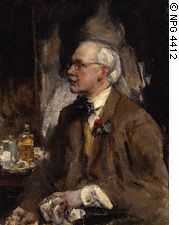|
James
Jebusa Shannon
American
artist
(1862-1923)
From: 1911 edition of an encyclopedia
SHANNON, JAMES JEBUSA (1862- ), Anglo-American
artist, was born at Auburn, New York, in 1862', and at the age of eight
was taken by his parents to Canada. When he was sixteen, he went to England,
where he studied at South Kensington, and after three years won the gold
medal for figure painting. His portrait of the Hon. Horatia Stopford, one
of the queen's maids of honor, attracted attention at the Royal Academy
in 1881, and in 1887 his portrait of Henry Vigne in hunting costume was
one of the successes of the exhibition, subsequently securing medals for
the artist at Paris, Berlin and Vienna. He soon became one of the leading
portrait painters in London. He was one of the first members of the New
English Art Club, and in 1897 was elected an associate of the Royal Academy,
and R.A. in 1909. His picture, " The Flower Girl," was bought in 1901 for
the National Gallery of British Art.
(1911
edition of an encyclopedia)
From: Mark Borghi Fine Art Inc
Sir James Jebusa Shannon was one
of the outstanding Society Portraitist of his day, his success lay in an
ability to paint portraits that appealed to the prevalent aesthetic taste
and these paintings reveal his artistic sensibility, fine sense of color
and stylistic bravura.
Born in Auburn, New York, of Irish
parentage, the family had settled in St Catherines, Ontario, by 1875 and
Shannon took his first art lessons from a local artist, William E Wright.
In 1878 he traveled to England and studied at the National Art Training
School under Sir Edward Poynter. As Poynter's most gifted pupil, he received
commissions from Queen Victoria in 1881 and 1882, and although he had intended
to return to the United States, the success of his early works persuaded
him to remain in London. In 1886 he married Florence Mary Cartwright and
a year later their daughter Kitty was born. He painted them on many occasions
and in these more intimate and informal works he expressed his true artistic
talent.
During the mid 1880s, Shannon, together
with his fellow American compatriot John Singer Sargent, dominated the
field of British portraiture. Shannon's popularity was encouraged by the
patronage of Violet Manners, later Marchioness of Granby, and he became
the Manners family's favorite artist.
Shannon was a prominent exhibitor
at the Royal Academy, the Grosvenor Gallery, the New Gallery and the Royal
Institute of Oil Painters. He was a founder member of the New English Art
Club in 1886, became a Royal Academician in 1909, was President of the
Royal society of Portrait Painters from 1910-1923 and was knighted in 1922.
Following his death, memorial exhibitions were held at the Leicester Galleries
in London and the Albright Art Gallery and the Cincinnati Museum, USA.
(Mark
Borghi Fine Art Inc)
From: Taylor Gallery, London
The son of Irish immigrants, Shannon
was born in Auburn, New York. In 1870 he moved with his family to Saint
Catherine's, Ontario where he displayed early artistic talent so much so
that his father sent him to study art at the South Kensington school in
London (now the Royal College of Art). There at the age of 18 he won the
gold medal in the annual competition of all the art schools in the United
Kingdom. He was immediately commissioned by Queen Victoria to paint the
portraits of the Hon. Horatio Stopford and Mrs Henry Bourke (both now in
the Royal Collection), which were exhibited at the Royal Academy in 1881
and 1882 respectively.
Based on this early success he decided
to stay in London where he became a noted society portrait artist. By 1892
he was so successful that he was able to purchase a substantial studio
in Holland Park Road where on and off he spent the rest of his life. He
was elected an associate of the London Academy of Arts in 1897.
In 1904 he went with his wife and
daughter Kitty for the first of three extended stays in America. There
he was very prolific and had three one-man exhibitions at M Knoedler and
Co in New York in 1905, 1906 and 1907.
He was President of the Royal Society
of Portrait Painters in 1910 and in 1922 renounced his U.S. citizenship
in order to accept the Knighthood that was given him in recognition of
his talents as a portrait artist.
He died in 1923 at the age of 61.
His work is represented in many major museums including the Metropolitan
in New York.
(Taylor
Gallery, London)
Notes
Articles
-
Christian Brinton “A Painter of
Fair Women” Munsey’s Magazine; May
1906
Bibliography
Christopher Wood, Dictionary of Victorian
Painters (Woodbridge: Antique Collectors' Club, 1971)
J. Johnson and A. Greutzner, Dictionary
of British Artists 1880-1940 (Woodbridge: Antique Collectors' Club, 1980)
Kenneth McConkey, Memory and Desire:
Painting in Britain and Ireland at the Turn of the Twentieth Century, (London,
2002).
(Mark
Borghi Fine Art Inc
1911
edition of an encyclopedia
Centre
for Whistler Studies |



